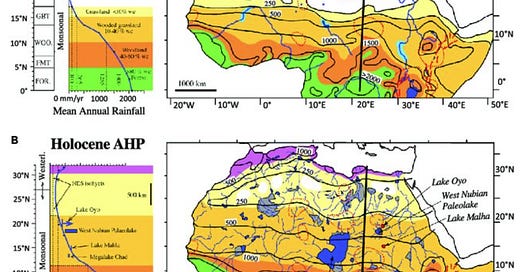Rethinking Climate Change: Lessons from the African Humid Period
Exploring Historical Climate Variability in Africa and Its Implications for Today's Environmental Challenges
The African Humid Period (AHP) is a well-documented climatic event that occurred in the Sahara and Sahel regions of Africa, at pre-industrial levels of GHGs, transforming these typically arid areas into lush landscapes with an abundance of flora and fauna. It serves as a crucial case study in understanding past climate dynamics and their drivers. This article explores the AHP, its underlying mechanisms, and how such dramatic climate swings challenge the simplicity of attributing all modern climate changes directly to anthropogenic greenhouse gas (GHG) emissions.

The AHP, which occurred approximately between 15,000 and 5,000 years ago, was a time when huge areas of North Africa, now arid or semi-arid, experienced significantly wetter conditions. This period, which occurred during remarkably stable CO2 concentrations (see figure below), is commonly attributed to changes in the Earth's orbit and axial tilt, which enhanced the monsoon systems and led to increased rainfall across the Sahara, transforming it into a savannah-like environment rich in lakes, rivers, and abundant vegetation. However, multiple recent studies suggest a much more rapid transition into and out of the AHP.
For example, a study published in Science Advances titled, “Rainfall regimes of the Green Sahara”, uses leaf wax isotopes from marine sediments to quantitatively reconstruct past precipitation in the western Sahara, a method that offers new insights into the rainfall patterns and the spatial extent of the Green Sahara. They conclude…
Our data indicate that the Green Sahara extended to 31°N and likely ended abruptly.
The findings indicate that during this period, the region received much higher rainfall than previously quantified, and suggests an abrupt end to the Green Sahara conditions. Importantly, the study highlights a temporary "pause" in these conditions around 8,000 years ago, which coincides with archaeological evidence of a hiatus in human occupation in the region. This pause in rainfall aligns with the 8.2-ka cooling event, suggesting a connection between global climate events and regional climate changes in the Sahara.
The study emphasizes the critical role of vegetation and dust feedback in the climate system, noting that these natural mechanisms greatly influence rainfall patterns. Climate models that do not adequately simulate these feedbacks fail to accurately reproduce past climatic conditions, such as those of the Green Sahara, and challenge the notion that climatic shifts like those observed during the Green Sahara period occur gradually and over long timescales, as the data suggest that transitions can be relatively abrupt.
Similar work near the Horn of Africa, published in Science in 2013 found…
Keep reading with a 7-day free trial
Subscribe to Irrational Fear to keep reading this post and get 7 days of free access to the full post archives.



